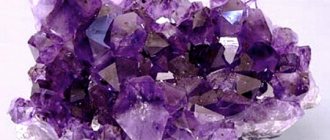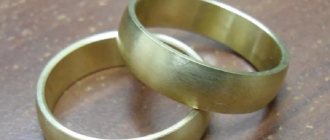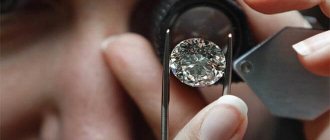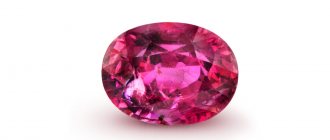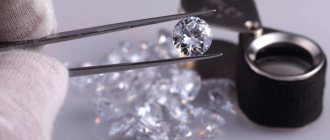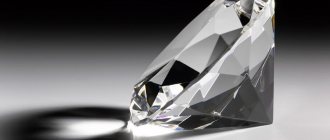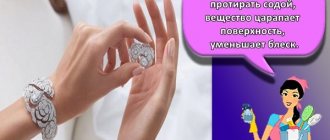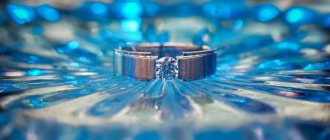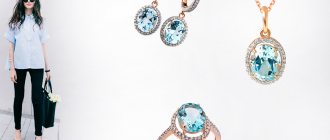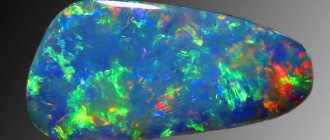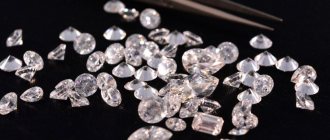| Stone type | Precious |
| Prevalence (Deposits) | Widely spread |
| Varieties | Verp light, Wisselton, Crystal, Light Brown, River, Top Wisselton, Top Cape, Top Crystal, Yater |
| Transparency | Transparent |
| Shine | Glass |
| Mohs hardness scale | 10 |
| Chemical composition | WITH |
| Color | Colorless, blue, yellow, green, brown, red, orange, pink, gray, black |
| Owner's color type | Winter summer |
| Owner's temperament | Choleric |
| Names | Venus, Daria, Ivan, Ilya, Inna, Christina, Leo, Maria |
| Zodiac sign | Leo, Aries, Sagittarius |
| Date of Birth | from March 21 to April 19 from July 23 to August 21 from November 22 to December 21 |
| Chinese horoscope | Rat |
| Element | Fire |
| Planet | Not found |
| Day of the week | Monday, Friday, Saturday, Sunday |
| Month | April, October |
| Season | Spring, autumn |
| Numerology vibration | 4, 6, 9 |
| Chakra | Sahasrara |
| What stones is it compatible with? | Agate, amethyst, white pearl, beryl, turquoise, emerald, coral, lapis lazuli, sapphire, carnelian |
| What stones is it not compatible with? | Malachite, onyx, obsidian, sardonyx |
| Therapeutic effect (problems) | bad habits, immunity, nervous disorders, rejuvenation, stress, phobias and groundless fears |
| Therapeutic effect (on organs) | Skin, respiratory organs, gastrointestinal tract organs, cardiovascular system, joints |
| Magic properties | Difficult life situations, self-confidence, strengthening relationships |
Diamond is one of the most popular jewelry stones.
The high cost of natural gems contributed to the creation of an artificial analogue - zirconium (cubic zirconia). Identifying a diamond and distinguishing it from cubic zirconia is quite simple if you know the main features of this stone and fakes. Real diamonds have special quality certificates that confirm their origin. But in some situations it is important to determine the authenticity of stones yourself by eye. In this article we will analyze the main characteristics of diamonds, how to check their authenticity at home and other nuances of the purchase.
What is a diamond?
Ordinary people often confuse diamonds and diamonds, believing that they are two different precious stones. In fact, a diamond is a very well-cut diamond. And diamonds have many uses:
- they are used in industry, for example, to create extremely hard saws and drills;
- they are processed and turned into valuable jewelry;
- They are used to make special coatings, for example, for frying pans, so that food does not burn.
The chemical composition of diamonds and rough diamonds is identical, so the only difference is in the scope of application and the presence of a cut. There are a lot of industrial diamonds in the world, but there are few suitable for turning into diamonds, and this gives them special value.
Entertaining secrets
Most people are convinced that a diamond cannot be seen in water, but this is just a myth and a general misconception. Stones of natural origin almost always have a yellowish tint, so they can be seen in water with the naked eye. Even specimens devoid of color are clearly visible.
Diamonds cannot be present in jewelry; if the seller claims that the jewelry contains a natural stone, then this is not true.
It is advisable to never visit dubious places to purchase diamonds; you can also always request a certificate for jewelry and read the documentation.
A moment of history
Diamond mining is a very difficult and very profitable business. Everyone knows about the gold rush, but few know that there was also a diamond rush. At the end of the 19th century, rich diamond deposits were discovered in Africa. The news quickly spread across the Old and New Worlds, and prospectors of all stripes flocked to South Africa. Subsequently, the city of Kimberley was founded there.
Miners of the past believed that diamonds formed in river beds. The truth turned out to be different: in fact, 90% of diamonds are mined in kimberlite pipes - natural wells of volcanic origin. These formations were named after that African settlement. They look like this:
Diamonds are found on all continents except Antarctica. In addition to Africa, large deposits of the valuable mineral are located in Russia, Australia and Canada.
The value of diamonds is partly due to the complexity of their processing. It is believed that diamond is an incredibly hard material that can cut glass and metal. This is true. However, the other side of the coin is increased fragility. The mineral is almost impossible to scratch, but relatively easy to break. Because of this, they did not dare to process it for a very long time, and only in the 15th century did the Indians offer an effective technology for making diamonds.
The word “diamond” itself translated from French means “shining, bright, brilliant.” This perfectly reflects the main thing in the appearance of the stone and the very thing for which beauty connoisseurs love it.
Description of the stones
Gems differ in origin. This leads to their physical characteristics and cost. A-priory:
- A diamond is an organic rock of volcanic origin. Diamonds (rough diamonds) are mined from the depths of the earth near geysers or volcanoes. Later they are cut in a special way.
- Cubic zirconias are synthesized zirconium dioxide crystals obtained by high-frequency melting. Cubic zirconias are processed to look like diamonds, but with fewer facets.
The refractive indices of stones are similar in value. This makes them shine, shimmer from the inside, playing with light.
Cubic zirconias also differ from diamonds in their hardness. Diamonds are considered the hardest gems in the world.
View this post on Instagram
Posted by Engagement Rings DIAMONDS (@wow.shine_jewelry) Jul 19, 2021 at 5:40 am PDT
What is cubic zirconia?
This is an artificial and relatively cheap material, very similar to a gemstone in appearance, but differing in properties. Its production is a rather difficult and painstaking process, but it cannot be compared in complexity to high-quality cutting of a diamond.
The price per gram of good cubic zirconia reaches $5.
The artificial mineral received its name from the Physical Institute of the Lebedev Academy of Sciences (FIAN). It was there that it was synthesized by a team of Soviet scientists in the 1970s. It is noteworthy that the goal of the project was to obtain a substance with special optical properties suitable for creating laser equipment.
Artificial stone has several names. Chemists know it as zirconium dioxide. In the West, it is more often called zirconite, jewellite or daimonstone.
The invention of Soviet scientists caused a real sensation among both fashionistas and jewelers. Compared to a diamond, this stone was worth pennies. In 1990, 50,000,000 carats of cubic zirconia were produced, and this is an astronomical amount. Every year the pace of production is accelerating, and more and more synthetic gems are entering the markets.
How to distinguish using a tester?
Diamond Tester
The Diamond Tester, a special device for authentication, is in great demand today.
The technique is used to measure the thermal conductivity of a material, which allows an effective result to be obtained.
The tester is recommended for those who frequently buy diamonds.
It is worth noting that even this does not always give an accurate result, since scammers have begun to make cubic zirconia with a precious coating.
Crystalline substrates are coated with a film of crystallized carbon, which makes it possible to fool most portable tester models.
Key differences between diamonds and cubic zirconias
We will also dwell on the intricacies of testing at home, but for now take a look at the table. It will make it clear what the basic differences between the stones are.
| Criterion | Diamond | cubic zirconia |
| weight | easy | 2-3 times heavier with the same volume |
| cut shape | sharp, clear edges | differs in slightly rounded edges |
| conductivity of heat | high (does not fog up) | low (fogs up) |
| the power of radiance | glare of high intensity due to excellent refractive power (with the correct cut and large stone size) | the intensity of the radiance is barely noticeably lower for large crystals, and higher for small ones |
| grease wettability | good, the shape of the fat trace is unchanged | bad, the fat trail spreads like a blot |
As you can see, there are differences, but they do not allow you to determine by eye what kind of stone is in front of you. It is unlikely to be possible to weigh them, because minerals are often inserted into rings and earrings.
The solution is in the ring
See Also How to choose,
Beauty and health
,
Makeup
,
Need to know
,
Helpful tips
,
Skin care
,
Facial care
Choosing a foundation
You can independently identify a fake stone in a ring by its markings. Natural stones always have a precious cut and are placed in a gold or platinum frame. There are special signs for identification. The crystal should be examined carefully.
If the diamond is in an open setting, it will play with light and sparkle, allowing you to see the hidden facets below. If the lower edges have a mirror coating, then this is a 100% fake; you should not purchase such a product at an expensive price.
Basic characteristics of a diamond
The price of a gemstone is determined by its quality. It consists of four main criteria:
- Carat.
- Features of the cut.
- Color.
- Purity of the stone.
Let's take a closer look at each of them.
Carat
To make it easier to measure precious stones and pearls, a non-systemic unit of mass was introduced - the carat. It is equal to 200 milligrams.
The heavier the stone, the more expensive it is.
The largest diamond found weighed an incredible 3,106 carats. The price of one carat of a good quality diamond is approximately 750,000 rubles. Remember what we said about the price of a gram of cubic zirconia...
How much will you have to pay?
The cost of accessories depends not only on the quantity and quality of the metal from which they are made. To a greater extent - from the weight and cleanliness of the inserts.
Women's rings with cubic zirconia are very popular due to their affordable price and wide range of colors of artificial stone. The minimum price for silver products with an insert weight of 0.04 carats is approximately 8,500 rubles.
But, for example, a white gold ring with a diamond weighing 0.51 carats will already cost from 116,000 rubles. The difference in price is obvious, so it is important to be able to determine the origin of the stone, and you should only buy jewelry in specialized jewelry stores.
Comparison of a real diamond and a fake at home
Not everyone is ready to shell out money to test a gem in a laboratory. However, there are many ways to verify the authenticity of a stone that you can use on your own.
Do you dream of diamonds?
Yes, I have
By certificate availability
You should only purchase expensive jewelry from trusted jewelry stores. There you will be given a certificate for the product confirming that the stone is of natural origin. Certification is carried out by various authoritative institutions, for example, the Gemological Center of Moscow State University or the most authoritative Gemological Institute of America. When purchasing from an unknown retail outlet or even secondhand, you run the risk of receiving a cubic zirconia product at a diamond price.
By price
Jewelry with a real diamond cannot be cheap. You can compare prices for different rings on the Internet and get an idea of what you can expect.
If a store offers to buy a product for 3000-8000 rubles, this is, at BEST, cubic zirconia. Most likely, scammers are offering a plastic or glass “stone”.
According to the seller's reaction
If you buy a stone, for example, in a Tiffani salon, it will be 100% genuine. But if you decide to purchase jewelry from a little-known showroom at a suspiciously attractive price, ask the seller for permission to scratch the stone. If a store sells real gems, the seller will agree, because a hard diamond can only be scratched with the same diamond. If an inspection is prohibited, this is a reason to think about it.
By cleanliness
Artificially created cubic zirconia has absolute purity, while a real diamond always has flaws. Take a magnifying glass and examine the stone. If you manage to find a small dot, cavity or darkening, you have the original.
Checking the stone for flaws
By cut
The cutting of a diamond is carried out at the highest level, because it determines whether the jewel will play with light. If you make a mistake at this stage, the diamond will turn into a cloudy and unattractive crystal. All edges must be smooth and sharp, symmetry must be maintained.
A cubic zirconia crystal usually has slightly rounded edges; they can double.
To notice this, you will need a very good magnifying glass (at least with tenfold magnification), or even better, a microscope.
Diamond cut pattern
With fat
A good method to independently determine the authenticity of a stone. Drip vegetable oil onto the surface of the mineral. The fat will flow smoothly over the surface of the diamond, and on the cubic zirconia it will separate into drops and blots. In addition, a greased genuine stone will stick to the glass, but an artificial one will not.
On sale you can find special felt-tip pens suitable for carrying out fat testing.
By hardness
This method is glorified in detective stories and TV series. Diamond can cut glass. Cubic zirconia can only scratch it. Use this method with caution so as not to damage the jewelry. And under no circumstances try to hit the stone with a hammer; neither the fake nor the original will withstand such a test.
You can run a nail file over the gem. If it leaves scratches, it means you got a fake. You can use sandpaper, just make sure there are no diamond chips on it.
To the light
If you are going to buy a large crystal, look through it at the sunlight. A genuine diamond should not allow rays to pass through; through it you will only see a blurry dot. Cubic zirconia is more transparent, you can easily read a book through it.
Using heat
The method is based on the different thermal conductivities of stones. If you breathe on a real diamond, nothing will happen. But cubic zirconia will fog up in such a situation. You can also simply take the stone in your hand and hold it for a few seconds. The real mineral will remain cool.
With acid
A very risky method is based on the fact that cubic zirconia will become stained under the influence of hydrochloric acid, but a genuine diamond will not change. We do not recommend using this method to recognize the authenticity of jewelry, as it can ruin everything.
Using ultraviolet
If you have an ultraviolet lamp, place a ring or earring with a stone under it. A real diamond will glow dimly blue, while a fake diamond will glow phosphorescent.
By density and weight
The method is suitable if the stone is not inserted into the jewelry. You will need electronic scales, a calculator, a glass of water and a thread. Check procedure:
- weigh the stone;
- place a glass of water on the scale instead of a stone;
- reset the electronic scales;
- attach the stone to a string and completely immerse it in water so that it does not touch the walls;
- divide the weight of the stone by the result that appears on the scale now.
If it turns out to be 6.25 or more, you are dealing with cubic zirconia. The density of real diamond is 3.51 g/cm³.
A fake can be identified simply by weight. Natural diamond will be heavier.
By frame
If you have a ring, earring or brooch, pay attention to what material they are made of. The setting of a real diamond is always made of precious metals such as gold or platinum. In this case, gold is taken at least 585 samples, and platinum - 900. This data must be on the product.
In cheap products, the frame is made of low-grade gold, silver, and in advanced cases - of steel.
Documents for purchasing a diamond
When purchasing diamonds, the buyer has the right to request a special product passport, a GIA certificate. This document states:
- crystal weight;
- cleanliness parameters;
- defects;
- origin of the stone.
Note! The seller is obliged to provide a passport/certificate for the gem free of charge. You can request paperwork for your diamond at any point of purchase (such as a large Sunlight chain or a small retail store). Any excuses and refusal to show documents about the manufacturing plant may indicate a forgery.
Professional authentication methods
When combining different home testing methods, the result is most likely to be correct. However, there are cases when the fake is made so well that it is impossible to do without the help of special equipment and expert knowledge. The hardest thing is to distinguish between diamond and moissanite, but cubic zirconia sometimes confronts a person with a non-trivial task. In general terms, we will convey how professionals work in such cases.
By reflection
The specialist takes a special device and analyzes the crystal. Diamond, glass, cubic zirconia or other material will have different reflection coefficients. This cannot be determined by eye, and the necessary device costs a lot.
By conductivity of electricity
Synthetic stones are semiconductors, meaning they conduct electricity. Experts have equipment that allows them to evaluate the degree of conductivity and make a conclusion about whether the stone is real.
Using a microscope
This magnifying device will allow you to see what is hidden from the most powerful magnifying glasses. The smallest defects, cutting features, sharpness of edges - these signs will indicate authenticity or fakeness.
Through an electron microscope you can see the grain structure of the crystal. In synthetic stones, at this magnification, clusters of microscopic-sized single crystals are visible. They seem to have grown together. In natural materials, single crystals are faceted.
Another option is to combine a polariscope with a microscope, and then in polarized light you will see “copies” of the seed crystal. Any single crystal, no matter how it grows, will repeat the shape of the seed. And the seed itself will be visible as a darkened zone in the middle of the former uncut crystal.
Special device
This device is often called a diamond tester. It has various modifications, allows you to determine the authenticity of stones and identify their number in each individual row of a particular piece of jewelry.
If the device only examines the thermal conductivity of a stone, then you can make a mistake here, because a diamond has a counterpart that is similar in this property. It's called moissanite. This is a synthetic stone created according to a program for creating non-natural diamonds. It has 90% the same thermal conductivity as a precious specimen.
There are testers that determine the authenticity of a stone by its refractive index. Moissanite has a higher coefficient than diamond. If the device is designed to work exclusively with polished specimens, then when checking an uncut nugget, the device will not produce any results.
That is why the best testers are considered to be those that test according to two indicators at once - thermal conductivity and light transmittance.
Don't overpay for something cheap
As you can see, recognizing a fake is not too difficult, but a specialist will still do it with one hundred percent accuracy. You should not be lazy in such a serious matter as buying jewelry - this can lead to extremely unpleasant consequences.
And remember: offers in the style of “jewelry for only 3000 (4000, 6000, 8000, etc.) rubles” are always false. Under the guise of a sale, scammers simply hand out glass pieces for large sums.
Buying jewelry is a difficult task that requires certain knowledge. You should know based on what parameters you can see a fake. Fortunately, the above methods will allow even an unknowing person to select a real diamond.
Remember that all this applies not only to transparent diamonds - zirconite is sometimes substituted for colored stones, simply giving them the desired color with the help of chemical additives. Sometimes they also replace other jewelry. Unscrupulous traders often try to make cheap jewelry more expensive in order to make a profit. A well-informed person will not fall for such tricks, so know how to distinguish a precious stone from an artificial one.
Read also: how to identify a diamond at home →
